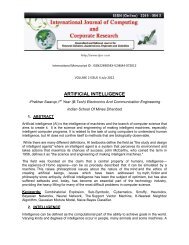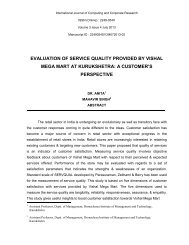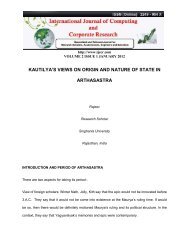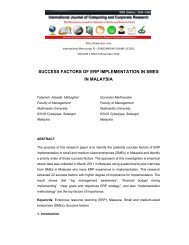media consumption habits of urban youth in haryana - Ijccr.com
media consumption habits of urban youth in haryana - Ijccr.com
media consumption habits of urban youth in haryana - Ijccr.com
Create successful ePaper yourself
Turn your PDF publications into a flip-book with our unique Google optimized e-Paper software.
http://www.ijccr.<strong>com</strong><br />
International Manuscript ID : ISSN2249054X-V2I2M3-032012<br />
VOLUME 2 ISSUE 2 March 2012<br />
MEDIA CONSUMPTION HABITS OF URBAN YOUTH IN HARYANA<br />
*Mr. Omesh Chadha, Faculty, Dept. <strong>of</strong> Management<br />
Delhi Institute <strong>of</strong> Technology and Management,<br />
Gannaur, Sonipat<br />
*Mr. Sandeep Chabbra, Faculty, Dept. <strong>of</strong> Management<br />
Delhi Institute <strong>of</strong> Technology and Management,<br />
Gannaur, Sonipat<br />
ABSTRACT<br />
Great brands are built on great conversations. To have an effective <strong>com</strong>munication with the customer it<br />
is must to understand them and their <strong>media</strong> <strong>consumption</strong> pattern. Today’s <strong>youth</strong>, especially <strong>urban</strong> is the<br />
most <strong>com</strong>plicated target segment <strong>in</strong> the market, because <strong>of</strong> their exposure to a variety <strong>of</strong> <strong>media</strong>, low<br />
attention span, unconventional norms & wide <strong>in</strong>terests. To <strong>com</strong>plicate the situation they have the<br />
power to escape... they can escape ads, they can tune <strong>in</strong> to a million other channels, they can buy a<br />
billion other products, they can publish a blog about a brand, they can have <strong>in</strong>stant word-<strong>of</strong>-mouth<br />
(good and bad) on it from the web, they can be <strong>in</strong> a store and punch <strong>in</strong> product <strong>in</strong>formation on their cell<br />
phone and f<strong>in</strong>d out who else has the product and for how much.
http://www.ijccr.<strong>com</strong><br />
International Manuscript ID : ISSN2249054X-V2I2M3-032012<br />
VOLUME 2 ISSUE 2 March 2012<br />
Despite difficulties, the great potential that this segment holds is the only attraction for the marketers that they<br />
cannot afford to overlook this segment, as it is the largest market segment <strong>in</strong> the Indian market. Marketers are<br />
always chas<strong>in</strong>g their attention, wherever they go and whatever they do. The basic task <strong>in</strong>volved <strong>in</strong> the<br />
development <strong>of</strong> <strong>media</strong> strategy is to determ<strong>in</strong>e the best match<strong>in</strong>g <strong>of</strong> <strong>media</strong> to the target market, given the<br />
constra<strong>in</strong>t <strong>of</strong> the budget Belch & Belch(2006) 1 . The <strong>media</strong> planner attempts to balance reach & frequency &<br />
deliver the message to the <strong>in</strong>tended audience with a m<strong>in</strong>imum waste <strong>of</strong> coverage.<br />
So, a research to study the <strong>media</strong> <strong>consumption</strong> pattern <strong>of</strong> the young <strong>urban</strong> customers can prove to be<br />
very useful <strong>in</strong> design<strong>in</strong>g <strong>media</strong> strategy to have an effective <strong>com</strong>munication with them.<br />
Keywords: Advertisement, Consumer, Consumption, Market<strong>in</strong>g Plan, Media.
http://www.ijccr.<strong>com</strong><br />
International Manuscript ID : ISSN2249054X-V2I2M3-032012<br />
VOLUME 2 ISSUE 2 March 2012<br />
1. INTRODUCTION<br />
When we were kids we were blamed <strong>of</strong> be<strong>in</strong>g a couch potato hypnotized by an Idiot Box called<br />
Television. It was the most important part <strong>of</strong> our childhood. At that time we never read newspaper but we<br />
remember watch<strong>in</strong>g every programme telecasted on doordarshan right from Krishi Darshan to Rozgaar<br />
Samachaar, as at that time there were no satellite channels & Internet. But today we don’t watch much<br />
TV and spend most <strong>of</strong> our day <strong>com</strong>municat<strong>in</strong>g <strong>in</strong> text through SMS, Scrapes & e-mails and yes <strong>of</strong> course<br />
read<strong>in</strong>g the newspapers, magaz<strong>in</strong>es & books and besides this we have our MP3 player & FM radio <strong>in</strong> our<br />
cell phones to enterta<strong>in</strong> us while travel<strong>in</strong>g. TV undoubtedly is the most actively present medium <strong>youth</strong>'s<br />
day, scor<strong>in</strong>g over all other options. A large portion <strong>of</strong> their spare time goes <strong>in</strong>to TV View<strong>in</strong>g. Late night<br />
view<strong>in</strong>g is also a popular phenomenon amongst this segment, which thus emerges as a territory worth<br />
tapp<strong>in</strong>g. Who could have predicted our <strong>media</strong> <strong>habits</strong> <strong>in</strong> our <strong>youth</strong> by observ<strong>in</strong>g us <strong>in</strong> our childhood? But<br />
it’s not just that we’ve changed. Media has changed so radically <strong>in</strong> the last few years. A new <strong>media</strong> called<br />
Internet has <strong>in</strong>vaded our lives & managed to capture most <strong>of</strong> our attention. The Indian <strong>youth</strong> uses the<br />
Internet most for email and then for chatt<strong>in</strong>g Pahwa N. (2006) 2 . Onl<strong>in</strong>e shopp<strong>in</strong>g, gam<strong>in</strong>g, dat<strong>in</strong>g/matchmak<strong>in</strong>g<br />
and travel are rather low <strong>in</strong> the list.<br />
A bulk <strong>of</strong> onl<strong>in</strong>e advertisements target the <strong>youth</strong>, and marketers are turn<strong>in</strong>g to the Internet to understand<br />
the <strong>youth</strong> better, particularly to blogs (the Sunsilk Gang <strong>of</strong> Girls portal gets mentioned for the gazillionth<br />
time). The <strong>youth</strong> doesn’t read newspapers and ‘new <strong>media</strong>’ allows them more choice and privacy. Mobile,<br />
however, isn’t as private and Onmobile is track<strong>in</strong>g users to make mobile advertis<strong>in</strong>g more relevant. There<br />
isn’t much on Social Media <strong>in</strong> India, though.<br />
Internet plays a prom<strong>in</strong>ent role among the young people <strong>in</strong> Hong Kong. A majority <strong>of</strong> respondents aged<br />
15 to 24 spend one to three hours per day <strong>in</strong> the <strong>in</strong>ternet. The ma<strong>in</strong> reasons for <strong>in</strong>ternet usage are for<br />
listen<strong>in</strong>g to music and for fun. The <strong>in</strong>ternet is the preferred <strong>media</strong> choice for <strong>in</strong>formation-driven activities.<br />
Magaz<strong>in</strong>es reta<strong>in</strong>ed importance for enterta<strong>in</strong>ment and shopp<strong>in</strong>g activities while the television reta<strong>in</strong>ed<br />
importance for news and current affairs. Most <strong>of</strong> the respondents found useful web sites through search
http://www.ijccr.<strong>com</strong><br />
International Manuscript ID : ISSN2249054X-V2I2M3-032012<br />
VOLUME 2 ISSUE 2 March 2012<br />
eng<strong>in</strong>es. Interpersonal <strong>in</strong>formation sources gave way to the <strong>in</strong>ternet for obta<strong>in</strong><strong>in</strong>g <strong>in</strong>formation about<br />
sensitive issues Chan & Fang (2007) 3 . .<br />
Today there is <strong>in</strong>tense <strong>com</strong>petition <strong>in</strong> the market. There are so many brands available for every s<strong>in</strong>gle<br />
product, each product claim its superiority over others. Marketers are spend<strong>in</strong>g huge amount on<br />
advertis<strong>in</strong>g.Marketers have devised a new term called 360° <strong>com</strong>munication; they are <strong>com</strong>municat<strong>in</strong>g<br />
24×7 with the customers. Advertis<strong>in</strong>g is not a simple game; availability <strong>of</strong> a wide variety has <strong>com</strong>plicated<br />
this process. Earlier Television was considered as the most popular mass <strong>media</strong> but today the Internet has<br />
be<strong>com</strong>e its tough <strong>com</strong>petitor especially for the <strong>urban</strong> <strong>youth</strong> audience. In general, <strong>media</strong> ownership,<br />
exposure and usage are higher among <strong>urban</strong> children than among rural children. However, television<br />
ownership and television exposure were slightly higher among rural children than among <strong>urban</strong> children.<br />
The <strong>urban</strong>-rural gap between <strong>media</strong> ownership and <strong>media</strong> exposure is more prom<strong>in</strong>ent for new <strong>media</strong> such<br />
as DVD and <strong>com</strong>puter/<strong>in</strong>ternet. Ch<strong>in</strong>ese children have low to medium attention to advertis<strong>in</strong>g. Rural<br />
children report a higher attention to television <strong>com</strong>mercial than <strong>urban</strong> children, while <strong>urban</strong> children<br />
reported a higher attention to other forms <strong>of</strong> advertis<strong>in</strong>g than rural children Chan & McNeal (2006) 4 .<br />
Sapero and Stone (2004) 5 studied the young adults' relationship with digital <strong>media</strong>. From a <strong>com</strong>mercial<br />
perspective the opportunity to deploy these channels to promote consumer recruitment and loyalty is very<br />
significant <strong>in</strong>deed. However, consumer market<strong>in</strong>g <strong>com</strong>panies will have to learn to meet the needs <strong>of</strong> this<br />
very discern<strong>in</strong>g and highly cynical audience by <strong>com</strong>b<strong>in</strong><strong>in</strong>g the best creative ideas and strategies with a<br />
transformed approach to market<strong>in</strong>g sales and service, embody<strong>in</strong>g the best <strong>of</strong> <strong>in</strong>formation and<br />
<strong>com</strong>munications technology, reliably and securely implemented. Communication networks underp<strong>in</strong> this<br />
report. While teens <strong>com</strong>pla<strong>in</strong> that they have less public space to hang out <strong>in</strong>, they are mak<strong>in</strong>g the onl<strong>in</strong>e<br />
world their milieu, their doma<strong>in</strong> where they develop personal relationships and where they play and learn<br />
new th<strong>in</strong>gs. The conclusions cover not only the effect <strong>of</strong> current market drivers, but also emerg<strong>in</strong>g trends<br />
that will allow brands to better understand the behaviour <strong>of</strong> young adults, so as to establish more truthful<br />
b<strong>in</strong>ds with them.
http://www.ijccr.<strong>com</strong><br />
International Manuscript ID : ISSN2249054X-V2I2M3-032012<br />
VOLUME 2 ISSUE 2 March 2012<br />
But then there is a segment <strong>of</strong> experts who believes that Television still rules the market and the most<br />
popular mass <strong>media</strong> among <strong>youth</strong>. In the market<strong>in</strong>g world there is a debate on this topic. Rachel Cooke<br />
(2002) 5 said that the growth <strong>of</strong> the Internet and mobile phone has not led to a reduction <strong>in</strong> television<br />
view<strong>in</strong>g, but <strong>in</strong>stead to fragmentation and diversification <strong>of</strong> the children’s <strong>media</strong> market, aided by the<br />
dramatic explosion <strong>in</strong> satellite and cable TV; children <strong>in</strong>teract with the different <strong>media</strong> forms <strong>in</strong> very<br />
different ways, each <strong>of</strong> them contribut<strong>in</strong>g to their enterta<strong>in</strong>ment requirements, and they can now<br />
<strong>com</strong>municate outside their traditional peer networks. New <strong>com</strong>munication channels are merely a way to<br />
reach consumers more efficiently; websites and mobile phones require high <strong>in</strong>vestment to <strong>in</strong>duce children<br />
to use them, and must avoid appear<strong>in</strong>g to be <strong>in</strong>trusive. While Rolfe and Gilbert (2006) 6 <strong>in</strong> a research<br />
found that the majority <strong>of</strong> young people do not love technology – they love <strong>com</strong>munication and<br />
enterta<strong>in</strong>ment, and technology is just the facilitator for these; it was also found that a surpris<strong>in</strong>gly large<br />
number <strong>of</strong> young people dislike and actively avoid us<strong>in</strong>g technology, particularly those from lower <strong>in</strong><strong>com</strong>e<br />
groups. .<br />
India is a very young country not because <strong>of</strong> its own age but because <strong>of</strong> its young population, which<br />
accounts for nearly fifty percent <strong>of</strong> its total population. It is very difficult for the marketers to catch their<br />
attention as the <strong>youth</strong> is surrounded with many distractions, and to beat the <strong>com</strong>petition, <strong>com</strong>munication is<br />
a very good strategy left with the marketers. The marketers are <strong>com</strong>municat<strong>in</strong>g with their target audience<br />
24×7 so that their brand can stay on the top <strong>of</strong> their customers m<strong>in</strong>ds. But when the target is <strong>youth</strong>, the<br />
marketers get confused as the <strong>youth</strong> has an exposure to a wide range <strong>of</strong> <strong>media</strong>. They have an exposure to<br />
at least two <strong>media</strong> at any po<strong>in</strong>t <strong>of</strong> time. So to have a better <strong>com</strong>munication with the target customer <strong>media</strong><br />
plann<strong>in</strong>g is the start<strong>in</strong>g step. It is the series <strong>of</strong> decisions <strong>in</strong>volved <strong>in</strong> deliver<strong>in</strong>g the promotional message to<br />
the prospective purchasers and/ or users <strong>of</strong> the product or brand. Media plan is a guide for <strong>media</strong><br />
selection. It is a process with the follow<strong>in</strong>g steps:<br />
THE MEDIA PLAN
http://www.ijccr.<strong>com</strong><br />
International Manuscript ID : ISSN2249054X-V2I2M3-032012<br />
The situation Analysis<br />
Purpose: to Understand the<br />
market<strong>in</strong>g problem. An analysis is<br />
made <strong>of</strong> a <strong>com</strong>pany & its<br />
<strong>com</strong>petitors on the basis <strong>of</strong>:<br />
1. Size and share <strong>of</strong> the total market.<br />
2. Sales history costs and pr<strong>of</strong>its.<br />
3. Distribution Practices.<br />
4. Methods <strong>of</strong> sell<strong>in</strong>g.<br />
5. Use <strong>of</strong> Advertis<strong>in</strong>g.<br />
6. Identification <strong>of</strong> prospects.<br />
7. Nature <strong>of</strong> the product.<br />
VOLUME The market<strong>in</strong>g 2 ISSUE strategy 2 March plan 2012<br />
Purpose: to plan activities that will<br />
solve one or more Figure1 <strong>of</strong> the market<strong>in</strong>g<br />
problems. Includes the<br />
determ<strong>in</strong>ation <strong>of</strong>:<br />
1. Market<strong>in</strong>g objectives.<br />
2. Product & spend<strong>in</strong>g strategy.<br />
3. Distribution strategy<br />
4. Which elements <strong>of</strong> market<strong>in</strong>g mix<br />
are to be used.<br />
5. Identification <strong>of</strong> “best” market<br />
segment.<br />
The creative strategy plan<br />
Purpose: to determ<strong>in</strong>e what to<br />
<strong>com</strong>municate through advertisements<br />
<strong>in</strong>cludes the follow<strong>in</strong>g:<br />
1. How product can meet consumer<br />
needs.<br />
2. How product will be positioned <strong>in</strong><br />
advertisements.<br />
3. copy themes<br />
4. Specific objectives <strong>of</strong> each<br />
advertisement.<br />
5. Number and size <strong>of</strong> advertisements.<br />
Sett<strong>in</strong>g <strong>media</strong> objectives<br />
Purpose: to translate market<strong>in</strong>g objectives & strategies <strong>in</strong>to goals that <strong>media</strong> can ac<strong>com</strong>plish.<br />
Determ<strong>in</strong><strong>in</strong>g <strong>media</strong> strategy<br />
Purpose: to translate <strong>media</strong> goals <strong>in</strong>to general guidel<strong>in</strong>es that will control that will control the planner’s selection and use <strong>of</strong><br />
<strong>media</strong>. The best strategy alternatives should be selected.<br />
Select<strong>in</strong>g broad <strong>media</strong> classes<br />
Purpose: to determ<strong>in</strong>e which broad class <strong>of</strong> <strong>media</strong> best fulfills the criteria. Involves <strong>com</strong>parison and selection <strong>of</strong> broad <strong>media</strong> classes such<br />
as newspapers, magaz<strong>in</strong>es, radio, television and others. The analysis is called <strong>in</strong>ter<strong>media</strong> <strong>com</strong>parison. Audience size is one <strong>of</strong> the major<br />
factors used <strong>in</strong> <strong>com</strong>par<strong>in</strong>g the various <strong>media</strong> classes.<br />
Select<strong>in</strong>g <strong>media</strong> with<strong>in</strong> classes<br />
Purpose: to <strong>com</strong>pare & select the best <strong>media</strong> with<strong>in</strong> broad classes, aga<strong>in</strong> us<strong>in</strong>g predeterm<strong>in</strong>ed criteria. Involves mak<strong>in</strong>g decisions about the follow<strong>in</strong>g:<br />
1. if magaz<strong>in</strong>es were re<strong>com</strong>mended, then which magaz<strong>in</strong>es?<br />
2. if television was re<strong>com</strong>mended, then<br />
a) Broadcast or cable television? c) if network, which program(s)?<br />
b) Network or spot television? d) if spot, which markets?<br />
3. if radio or newspapers were re<strong>com</strong>mended, then<br />
a. which market shall be used? B. what criteria shall buyers use <strong>in</strong> mak<strong>in</strong>g purchases <strong>of</strong> local <strong>media</strong>?<br />
Media use decisions – broadcast<br />
1. What k<strong>in</strong>d <strong>of</strong> sponsorship (sole, shared,<br />
participat<strong>in</strong>g or other)?<br />
2. What level <strong>of</strong> reach & frequency will be<br />
required?<br />
3. Schedul<strong>in</strong>g: on which days & months are<br />
<strong>com</strong>mercials to appear?<br />
4. placement <strong>of</strong> sports: <strong>in</strong> programmes or<br />
between the programs?<br />
Media use decisions – pr<strong>in</strong>t<br />
1. Number <strong>of</strong> ads to appear and so which<br />
days and months?<br />
2. Placements <strong>of</strong> ads: any preferred<br />
position with<strong>in</strong> <strong>media</strong>?<br />
3. Special treatment: Gatefolds, bleeds,<br />
color etc.<br />
4. Desired reach <strong>of</strong> frequency levels.<br />
Media use decisions – other <strong>media</strong><br />
1. Billboards<br />
a. Location <strong>of</strong> markets and plan <strong>of</strong><br />
distribution.<br />
b. k<strong>in</strong>ds <strong>of</strong> outdoor boards to be used.<br />
2. Direct mail or other <strong>media</strong>:<br />
Decisions peculiar to those <strong>media</strong><br />
Source: George E. Belch & Michael A. Belch “Advertis<strong>in</strong>g and Promotion” New Delhi: Tata McGraw –<br />
Hill Publish<strong>in</strong>g Company Limited, 2006, P. 304
http://www.ijccr.<strong>com</strong><br />
International Manuscript ID : ISSN2249054X-V2I2M3-032012<br />
VOLUME 2 ISSUE 2 March 2012<br />
This research report aims at ga<strong>in</strong><strong>in</strong>g <strong>in</strong>sight <strong>in</strong>to the <strong>media</strong> <strong>consumption</strong> <strong>habits</strong> <strong>of</strong> <strong>urban</strong> <strong>youth</strong> <strong>in</strong> Haryana,<br />
how it is chang<strong>in</strong>g & to f<strong>in</strong>d out which <strong>media</strong> & <strong>media</strong> vehicle is the most popular among them, as it would<br />
help the marketers to <strong>com</strong>municate with them <strong>in</strong> a better way.<br />
1.2 INDIA – THE YUNGISTAAN<br />
One <strong>of</strong> the world’s hottest economies <strong>in</strong>hibited by a billion people, roughly half <strong>of</strong> them is between the<br />
ages 15 – 29 years and their purchas<strong>in</strong>g power is soar<strong>in</strong>g an all time high. Accord<strong>in</strong>g to MTV<br />
International well be<strong>in</strong>g study (2008) 7 , <strong>youth</strong> across India spend up to Rs. 9 billion as pocket money<br />
every day. It is made up <strong>of</strong> a generation that has grown up with more choices, more access to<br />
<strong>in</strong>formation, more money to spend and opportunities than any other generation <strong>of</strong> Indians before it.<br />
India's <strong>youth</strong> are already hav<strong>in</strong>g an enormous impact: on the economy, on <strong>com</strong>panies hop<strong>in</strong>g to sell them<br />
products, on the <strong>media</strong>, and on the culture. Liberalization's children also differ from their conservative<br />
parents <strong>in</strong> that they proudly mix Indian values with Western packag<strong>in</strong>g. They enjoy wear<strong>in</strong>g blue jeans,<br />
dr<strong>in</strong>k<strong>in</strong>g fizzy sodas, and watch<strong>in</strong>g MTV. But they also like wear<strong>in</strong>g saris and still admire Mahatma<br />
Gandhi. That’s what makes Indian Youth’s <strong>media</strong> <strong>consumption</strong> <strong>habits</strong> worth study<strong>in</strong>g.<br />
1.3 INDIAN YOUTH - DNA<br />
“Personify<strong>in</strong>g Consumerism, Defy<strong>in</strong>g Conventional Norms, Demand Value for Money & Customer<br />
Satisfaction, Hectic Schedules, Low Attention Spans" these are just some phrases that make an<br />
attempt at captur<strong>in</strong>g what the Indian <strong>youth</strong> is all about.” Nayyar (2002) 8<br />
This <strong>youth</strong> will demand a more cosmopolitan society that is a full-fledged member <strong>of</strong> the global economy.<br />
They will start their own bus<strong>in</strong>esses and contribute to a more vibrant economy. They also are likely to<br />
demand more accountability from their politicians. ''This is the generation that is reclaim<strong>in</strong>g India's future,''<br />
says Gurcharan Das, a former chief executive <strong>of</strong> Procter & Gamble Co. India and author <strong>of</strong> a forth<strong>com</strong><strong>in</strong>g<br />
book on India <strong>in</strong> the next century.<br />
MTV <strong>in</strong> its latest <strong>youth</strong> study classifies <strong>youth</strong> as follows:<br />
• Homebodies who are traditional, collective and have low <strong>in</strong>dividuality
http://www.ijccr.<strong>com</strong><br />
International Manuscript ID : ISSN2249054X-V2I2M3-032012<br />
VOLUME 2 ISSUE 2 March 2012<br />
• Two-faced - <strong>in</strong>wardly traditional, outwardly modern<br />
• Wannabes - those who show-<strong>of</strong>f, are materialistic, desperate to be a part <strong>of</strong> a crowd<br />
• Rebels who want to th<strong>in</strong>k and do differently but who wont rebel overtly<br />
• Cool guys, who work hard, play hard, are confident, have strong <strong>in</strong>dividuality and are full <strong>of</strong><br />
aspirations.<br />
Yes, <strong>youth</strong> seem to <strong>com</strong>e <strong>in</strong> all shapes, sizes and, if one may add, attitudes. All this has made Indian<br />
Youth’s DNA really difficult to decode.<br />
Youth is the most hard to please segment for the marketers, yet they cannot afford to ignore them but<br />
before start<strong>in</strong>g market<strong>in</strong>g to <strong>youth</strong>, the marketer needs to connect to them with different <strong>media</strong>. Thus for a<br />
marketer it is important to understand what they watch, listen or read.<br />
2.1 OBJECTIVES OF THE STUDY<br />
This research work is an attempt to study the general <strong>media</strong> exposure <strong>of</strong> today’s <strong>urban</strong> <strong>youth</strong>.<br />
The ma<strong>in</strong> objectives are<br />
1) To study the <strong>media</strong> <strong>consumption</strong> pattern <strong>of</strong> <strong>urban</strong> <strong>youth</strong> <strong>in</strong> India;<br />
2) To f<strong>in</strong>d which <strong>media</strong>: Television or Internet is the most popular <strong>media</strong> among Indian <strong>urban</strong><br />
3) To study <strong>in</strong>teraction <strong>of</strong> <strong>youth</strong> with each medium – Consumption & Usage trend.<br />
4) To identify opportunity zones to advertise for <strong>youth</strong>.<br />
2.2 Sampl<strong>in</strong>g Design<br />
For the purpose <strong>of</strong> research, an Exploratory cum Descriptive study was carried out among a limited sample<br />
<strong>of</strong> 100 respondents <strong>in</strong> the age group <strong>of</strong> 18 – 25 years from Karnal, Panipat, Sonepat & Rohtak.<br />
Convenience sampl<strong>in</strong>g is used to select the sample. 25 respondents were taken from each city.<br />
2.3 Data Collection and Interpretation:
http://www.ijccr.<strong>com</strong><br />
International Manuscript ID : ISSN2249054X-V2I2M3-032012<br />
VOLUME 2 ISSUE 2 March 2012<br />
This research paper is based on the primary data. A structured questionnaire was prepared & survey has<br />
been conducted to collect the data. After collect<strong>in</strong>g the data it has been analysed with the help <strong>of</strong> tables &<br />
graphs to present them <strong>in</strong> a understandable form.<br />
Media Consumption Pattern <strong>of</strong> Urban Youth<br />
1. The most popular <strong>media</strong> among <strong>youth</strong><br />
Figure 2<br />
80%<br />
70%<br />
70%<br />
%age <strong>of</strong> the Respondents<br />
60%<br />
50%<br />
40%<br />
30%<br />
20%<br />
30%<br />
TV<br />
Internet<br />
10%<br />
0%<br />
1<br />
TV<br />
Internet<br />
Interpretation: Television is the most popular <strong>media</strong> among <strong>youth</strong> <strong>in</strong> terms <strong>of</strong> the usage. Its usage is<br />
highest among all the alternatives. The ma<strong>in</strong> reason is easy availability & low cost as <strong>com</strong>pare to Internet.<br />
2. Preferred <strong>media</strong> for enterta<strong>in</strong>ment, News & Information.<br />
Table 1 Figure 3<br />
TV<br />
Internet<br />
Enterta<strong>in</strong>ment 55% 45%<br />
News 87% 13%<br />
Information 28% 72%<br />
100%<br />
87%<br />
90%<br />
80%<br />
72%<br />
70%<br />
55%<br />
60%<br />
45%<br />
50%<br />
40%<br />
28%<br />
30%<br />
20%<br />
13%<br />
10%<br />
Enter ta<strong>in</strong>tment News Inf or mation<br />
Interpretation: Television is the most preferred source for enterta<strong>in</strong>ment & News, As television put less<br />
stra<strong>in</strong> on eyes than <strong>in</strong>ternet. but to get <strong>in</strong>formation Internet is used as it has an unlimited stock <strong>of</strong><br />
<strong>in</strong>formation on any topic <strong>of</strong> the respondents’ choice while the scope <strong>of</strong> Television is very limited on<br />
gett<strong>in</strong>g <strong>in</strong>formation <strong>of</strong> your choice.<br />
0%<br />
Use<br />
TV<br />
Inter net
http://www.ijccr.<strong>com</strong><br />
International Manuscript ID : ISSN2249054X-V2I2M3-032012<br />
VOLUME 2 ISSUE 2 March 2012<br />
3. Time per day spent watch<strong>in</strong>g TV & surf<strong>in</strong>g Internet<br />
Table 2<br />
TV<br />
Internet<br />
Average time 4-5 Hrs per day 2-3 Hrs per day<br />
Interpretation: The <strong>urban</strong> <strong>youth</strong> <strong>in</strong> Haryana spend more time watch<strong>in</strong>g Television than surf<strong>in</strong>g<br />
Internet, because <strong>of</strong> the reasons like High cost <strong>of</strong> surf<strong>in</strong>g Internet than watch<strong>in</strong>g TV, High stra<strong>in</strong> on<br />
eyes while surf<strong>in</strong>g Internet and more <strong>com</strong>fortable posture while watch<strong>in</strong>g TV. Moreover Internet is<br />
used by the Urban Youth <strong>in</strong> Haryana ma<strong>in</strong>ly for chatt<strong>in</strong>g with friends & scrapp<strong>in</strong>g & the duration <strong>of</strong><br />
surf<strong>in</strong>g Internet is dependent upon the time for which the friends are available on l<strong>in</strong>e for<br />
<strong>com</strong>munication, this <strong>in</strong> turn is affected by the availability <strong>of</strong> Internet to both the <strong>com</strong>municator.<br />
Some time this <strong>com</strong>munication l<strong>in</strong>k is broken due to power cuts etc.<br />
4. Preferred TV Channel for the follow<strong>in</strong>g<br />
Table 3<br />
Rank<br />
1 2 3 4<br />
Consumption<br />
General Enterta<strong>in</strong>ment Star One NDTV Imag<strong>in</strong>e Sony Zee TV<br />
Movies Cable TV Zee C<strong>in</strong>ema Star Gold Set Max<br />
News NDTV India Aaj Tak NDTV24×7 Star News<br />
Sports Star Sports Ten Sports ESPN DD Sports<br />
Music MTV 9 xm Channel V Punjabi music<br />
channel<br />
Knowledge<br />
National<br />
Geography<br />
Discovery CNBC News -
http://www.ijccr.<strong>com</strong><br />
International Manuscript ID : ISSN2249054X-V2I2M3-032012<br />
VOLUME 2 ISSUE 2 March 2012<br />
Interpretation: Star one rules the category <strong>of</strong> general enterta<strong>in</strong>ment TV Channel, for Movies local<br />
Cable TV channels are preferred as new movies are telecasted on them, NDTV is considered to<br />
be more authentic and preferred news channel while Star Sports, MTV & National Geographic<br />
channels are the most preferred channels for Sports, Music & Knowledge.<br />
5. Accessibility to Internet<br />
Figure 4<br />
100%<br />
90%<br />
86%<br />
%age <strong>of</strong> the Respondents<br />
80%<br />
70%<br />
60%<br />
50%<br />
40%<br />
30%<br />
20%<br />
14%<br />
YES<br />
No<br />
10%<br />
0%<br />
1<br />
Yes<br />
No<br />
Interpretation:<br />
The penetration rate <strong>of</strong> <strong>in</strong>ternet is very high <strong>in</strong> Urban Haryana as 86% <strong>of</strong> the respondents have<br />
accessibility to Internet.<br />
6. Place <strong>of</strong> surf<strong>in</strong>g Internet<br />
Figure 5
http://www.ijccr.<strong>com</strong><br />
International Manuscript ID : ISSN2249054X-V2I2M3-032012<br />
VOLUME 2 ISSUE 2 March 2012<br />
50%<br />
45%<br />
%age <strong>of</strong> the Respondents<br />
40%<br />
35%<br />
30%<br />
25%<br />
20%<br />
15%<br />
10%<br />
Series1<br />
5%<br />
0%<br />
At Home Net Café Office Cell Phone<br />
Interpretation: Most <strong>of</strong> the respondents surf <strong>in</strong>ternet from their respective home, followed by<br />
Internet Café & Office. Internet on the cell phone is the latest addition to the <strong>media</strong> for surf<strong>in</strong>g<br />
<strong>in</strong>ternet as it is very cost effective and provides anywhere connectivity.<br />
7. Which is your favorite web site for the follow<strong>in</strong>g?<br />
Table 4<br />
Rank<br />
1 2 3 4<br />
Usage<br />
E-mail Gmail Yahoomail Rediffmail Hotmail<br />
Information Google Wikipedia - -<br />
Social<br />
Orkut Facebook Hi5 Tagged<br />
Network<strong>in</strong>g<br />
Job Hunt Naukri.<strong>com</strong> Timesjob Monster Fresher<br />
world<br />
Music<br />
Download<br />
Papuyaar.<strong>com</strong> Songs.pk Mp3hungama Apnemp3
http://www.ijccr.<strong>com</strong><br />
International Manuscript ID : ISSN2249054X-V2I2M3-032012<br />
VOLUME 2 ISSUE 2 March 2012<br />
Interpretation: Gmail is the most popular website for send<strong>in</strong>g Emails , for Information search<br />
Google is used. Orkut rocks among Social Network<strong>in</strong>g web sites. While Naukri and Papuyaar are<br />
the populare websites for Job Hunt and Music download respectively.<br />
FINDINGS<br />
1. Internet is the most preferred <strong>media</strong> among <strong>youth</strong> as around 85% <strong>of</strong> the respondents preferred Internet<br />
to Television but they spend more time watch<strong>in</strong>g TV than surf<strong>in</strong>g Internet.<br />
2. 73% <strong>of</strong> the respondents today dedicate more time watch<strong>in</strong>g TV from 4-5 hrs per day. A large portion <strong>of</strong><br />
their spare time goes <strong>in</strong>to watch<strong>in</strong>g TV. Late night Television view<strong>in</strong>g and Internet surf<strong>in</strong>g is also a<br />
popular phenomenon with amongst this segment.<br />
3. 76% <strong>of</strong> the respondents preferred Television to Internet for enterta<strong>in</strong>ment purpose. Sports, Movies &<br />
Music keeps them busy.<br />
4. Channel switch<strong>in</strong>g is done at a very high rate <strong>of</strong> say 5-6 channels per 5 m<strong>in</strong>utes. Commercial break is<br />
generally avoided by 78% <strong>of</strong> the respondents.<br />
5. Star One, NDTV India, Cable movie channel, MTV, Star Sports are the most popular TV channels for<br />
General enterta<strong>in</strong>ment, News, Movies, Music & Sports.<br />
6. The penetration rate <strong>of</strong> Internet is very high <strong>in</strong> Indian households as 86% <strong>of</strong> the respondents have<br />
accessibility to Internet and 44% <strong>of</strong> the respondents surf Internet from their respective homes.<br />
7. Social Network<strong>in</strong>g is the most popular activity on Internet, which keeps them busy most <strong>of</strong> the time.<br />
8. At a time the respondents surf at least 3 websites. Orkut, Yahoo messenger are always on.<br />
9. G-mail, Yahoo, Google, Wikipedia, Naukri.<strong>com</strong>, Orkut, Papuyaar.<strong>com</strong> etc. are the most popular<br />
websites for send<strong>in</strong>g Emails, Information search, Job Hunt<strong>in</strong>g, Social Network<strong>in</strong>g & Music Downloads.<br />
10. There is another category <strong>of</strong> <strong>in</strong>ternet websites which is be<strong>com</strong><strong>in</strong>g a huge success among the Youth and<br />
that it the websites for send<strong>in</strong>g free Text Messages on the cell phone free <strong>of</strong> cost all around India &<br />
160by2 is the most popular website <strong>in</strong> this category.
http://www.ijccr.<strong>com</strong><br />
International Manuscript ID : ISSN2249054X-V2I2M3-032012<br />
VOLUME 2 ISSUE 2 March 2012<br />
11. The Urban <strong>youth</strong> <strong>in</strong> Harayana is not watch<strong>in</strong>g the daily soap operas. They prefer watch<strong>in</strong>g Reality<br />
Shows, Music, Movies, Discovery, National Geographic channel, Wrestl<strong>in</strong>g and even News but not<br />
daily Saas Bahu saga.<br />
12. There is a reference group to which the <strong>youth</strong> relates to, and if any advertisement uses the models <strong>of</strong><br />
that particular group than it is able to catch their attention otherwise it is not.<br />
13. Humourous and Emotional advertisements are best liked by the <strong>urban</strong> <strong>youth</strong> <strong>in</strong> Haryana.<br />
14. Advertisements target<strong>in</strong>g Youth should use Catchy phrases, themes revolv<strong>in</strong>g around <strong>youth</strong>’s world<br />
should be used to br<strong>in</strong>g out most desired results.<br />
15. Any th<strong>in</strong>g that is Unconventional, less formal, full <strong>of</strong> energy, different <strong>in</strong> any sense is able to break the<br />
clutter and is able to snatch a few moments <strong>of</strong> their attention from their highly distracted m<strong>in</strong>ds.<br />
SUGGESTIONS<br />
1. Unconventional is conventional for the <strong>youth</strong>. Anyth<strong>in</strong>g unconventional will attract & hold the<br />
attention <strong>of</strong> the <strong>youth</strong>. So marketers should keep this <strong>in</strong> m<strong>in</strong>d while design<strong>in</strong>g a <strong>com</strong>munication<br />
strategy for them.<br />
2. The Ads target<strong>in</strong>g Youth should be creative enough to catch their attention as their attention<br />
span is very short.<br />
3. Today’s <strong>youth</strong> is surrounded by many distractions, so the <strong>media</strong> & advertisement should be able<br />
to break the clutter.<br />
4. Internet is a very powerful but underutilized <strong>media</strong> to target <strong>youth</strong>, the marketers should use it<br />
fully.<br />
5. There are many uncharted territories for the marketers to <strong>com</strong>municate with the <strong>youth</strong> like<br />
mobile phones. The marketers should try to avail this as it hold a lot <strong>of</strong> potential.<br />
CONCLUSION
http://www.ijccr.<strong>com</strong><br />
International Manuscript ID : ISSN2249054X-V2I2M3-032012<br />
VOLUME 2 ISSUE 2 March 2012<br />
So, it can be said that TV and Internet are the strong & closest <strong>com</strong>petitors fight<strong>in</strong>g for the <strong>youth</strong>’s<br />
attention. But TV undoubtedly rules the popular <strong>media</strong> category for <strong>urban</strong> <strong>youth</strong> <strong>in</strong> Haryana. The<br />
reasons are many for this <strong>in</strong>clud<strong>in</strong>g high Cost <strong>of</strong> surf<strong>in</strong>g Internet than watch<strong>in</strong>g Television. almost<br />
same <strong>media</strong> & <strong>media</strong> vehicle is preferred by the boys & girls. Youth’s world is highly dynamic and a<br />
lot <strong>of</strong> developments are tak<strong>in</strong>g place <strong>in</strong> their world. They are not loyal to a particular <strong>media</strong>, channel<br />
& website, they give a try to every th<strong>in</strong>g available to them and the one that is different, fresh and<br />
excit<strong>in</strong>g is able to catch their attention. The <strong>media</strong> planners should keep themselves aware <strong>of</strong> the<br />
latest developments <strong>in</strong> the <strong>youth</strong>’s world so as to keep their <strong>media</strong> ahead <strong>of</strong> others <strong>in</strong> this most<br />
happen<strong>in</strong>g world, otherwise all their efforts would go waste.<br />
References:<br />
1. George E. Belch & Michael A. Belch (2006), Advertis<strong>in</strong>g & Promotion, Tata McGraw Hill, 6 th Edition<br />
2. Nikhil Pahwa, “What The Youth Wants: Trends In Media Consumption”,<br />
http://www.contentsutra.<strong>com</strong>/entry/what-the-<strong>youth</strong>-wants-trends-<strong>in</strong>-<strong>media</strong>-<strong>consumption</strong>/<br />
3. Kara Chan, Wei Fang, “Use <strong>of</strong> the Internet & Traditional Media among young people”, Young<br />
Consumers: Insight & Ideas for responsible Marketers, 2007<br />
4. Kara Chan, James U. McNeal, “Children and <strong>media</strong> <strong>in</strong> Ch<strong>in</strong>a: an <strong>urban</strong>-rural <strong>com</strong>parison study”,<br />
Journal <strong>of</strong> Consumer Market<strong>in</strong>g, 2006 Volume: 23, Issue: 2.<br />
5. Ian Sapero, Merl<strong>in</strong> Stone, “Agents <strong>of</strong> change: how young consumers are chang<strong>in</strong>g the world <strong>of</strong><br />
market<strong>in</strong>g”, Qualitative Market Research: An International Journal, 2004.<br />
6. Rachel Cooke, “ Kids and Media”, Young Consumers: Insight and Ideas for Responsible Marketers,<br />
2002<br />
7. Julian Rolfe, Mischa Gilbert, “ Young, new <strong>media</strong>, technology and <strong>com</strong>munication”, Young<br />
Consumers: Insight and Ideas for Responsible Marketers, 2006.<br />
8. MTV, “The Truth About Youth”, Brand Equity, The Economic Times, March 19, 2008, Pg. 4<br />
9. Anita Nayyar, “The Mysterious & Unpredictable Indian Youth - Unique <strong>in</strong> his <strong>media</strong> <strong>consumption</strong><br />
Habits." (Aug. 30. 2002), http://www.exchange4<strong>media</strong>.<strong>com</strong>/e4m/others/<strong>youth</strong>buzz.asp
http://www.ijccr.<strong>com</strong><br />
International Manuscript ID : ISSN2249054X-V2I2M3-032012<br />
VOLUME 2 ISSUE 2 March 2012











